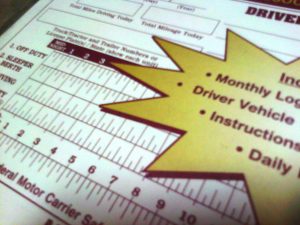Basic trucking Hours of Service is something truck drivers work with every day. Canadian truck drivers need to understand both the Canadian HOS rules and the American HOS rules.
Join the Len Dubois Trucking team today! We have opportunities for owner operators and company drivers. We are a Winnipeg trucking company with almost 30 years in the business.
 Understanding the Hours of Service (HOS) rules is a must for every truck driver. These rules govern how much we can work and how much rest we must have in order to conduct our jobs safely. HOS rules are not complicated – once you get to work with them for a while.
Understanding the Hours of Service (HOS) rules is a must for every truck driver. These rules govern how much we can work and how much rest we must have in order to conduct our jobs safely. HOS rules are not complicated – once you get to work with them for a while.
Canadian & USA Hours of Service
Trucking in Canada means most over-the-road truck divers cross into the United States. Canadian truck drivers need to understand and comply with both Canadian & American HOS rules. On days where we drive on both sides of the border we need to be in compliance in each jurisdiction.
Basic HOS In Canada
Canadian HOS rules differ from the American rules. In Canada, when speaking of how long you can drive, the rules speak of “per day” and “work shift”. Per day refers to a calendar day and a work shift refers to the time between two periods of rest of at least 8 hours. You need to be in compliance with both – the day and the work shift at all times.
Cycles
- Canada has two duty cycles – a 70 hours in 7-days and a 120 hours in 14-day cycle. You need to declare which cycle you are using every day in your logbook.
- When using the 70 hours in 7 days cycle (Cycle 1) you cannot log more than 70 hours On-Duty (Driving & On-Duty Not Driving) in 7 days.
- When using the 120 hours in 14 days cycle (Cycle 2) you cannot log more than 120 hours On-Duty (Driving & On-Duty Not Driving) in 14 days. In addition, when using this cycle you cannot not drive after accumulating 70 hours on-duty without taking a period of 24 consecutive hours off-duty.
- In both cycles you must have a period of at least 24 consecutive hours off-duty in the preceding 14 days.
Reset Rules or Switching Cycles
- If you’re using the seven-day cycle (cycle 1), to reset your hours to zero, you must take 36 consecutive hours off-duty.
- If you’re using 14-day cycle, to reset your hours to zero, you must take 72 consecutive hours off-duty.
- You must reset your hours in order to switch from cycle 1 to cycle 2 and vice versa. This means in order to switch from cycle 1, to cycle 2, you must log 36 consecutive hours of Off-Duty. In order to switch from cycle 2, to cycle 1, you need to log 72 consecutive hours of Off-Duty.
Daily Driving
- You’re limited to 13 hours of Driving time in a day or a work shift. This rule is pretty straightforward. In a day and a work shift you cannot log more than 13 hours as “Driving.” In order to drive again you must be Off-Duty for 8 consecutive hours. Off duty includes Off-Duty and Sleeper.
- You cannot Drive once you have 14 hours of on-duty time in a day or work shift. On-Duty includes “Driving” and “On-Duty Not Driving.” You can still log On-Duty Not Driving after 14 hours on-duty, but you cannot log “Driving.” In order to drive again you must be Off-Duty for 8 consecutive hours. Off duty includes Off-Duty and Sleeper.
- No Driving after 16 hours of time has elapsed between the conclusion of the most recent period of 8 or more consecutive hours of off-duty time and the beginning of the next period of 8 or more consecutive hours of off-duty time. This is referred to as the “16 hour” rule. It’s a ticking clock, which starts once you mark yourself on-duty. 16 hours from that point you cannot longer log Driving. You need 8 consecutive hours Off-Duty in order to drive again.
- You need to log at least 10 hours of off-duty time in a day.
Basic HOS in the United States
The American HOS rues are simpler but a bit more restrictive. One of the most common mistakes is forgetting to log the 30-minute break. Drivers must take a 30-minute break, at a time of their choosing, within the previous 8 hours. Meaning you have an 8-hour clock that needs to reset with a 30-minute break. The 8-hour clock starts again after the 30-minute break. The 8 hours is running in real time like your 14 hour rule (and 16 hour in Canada).
Duty Cycles
The Americans have two duty cycles – 70 hours in 8 days and 60 hours in 7 days. These cycles are pretty self-explanatory. You need to be in compliance with at least one of them and know which one your using.
Daily Driving
- You can drive a maximum of 11 hours after 10 consecutive hours off duty.
- You must take a 30-minute break, at a time of your choosing, within the previous 8 hours. This means before 8 hours, in real time, has past you need to take a 30-minute break. The 8-hour clock starts again once you complete your break.
- You cannot drive beyond the 14th hour after coming on duty, following 10 consecutive hours off duty. This works like the 16-hour rule in Canada, but it’s 14 hours and 10 hours Off-Duty. This differs from Canada, in that; your 10 hours must include 8 consecutive hours of Sleeper Birth time.
Reset
You can reset your hours to zero with 34 consecutive hours Off-Duty.
It’s important to keep your logbook legible and up-to-date to your last duty status change. Tickets, even warning tickets, for administrative mistakes go against our safety rating. We are expected to be in compliance with all HOS rules at all times.





